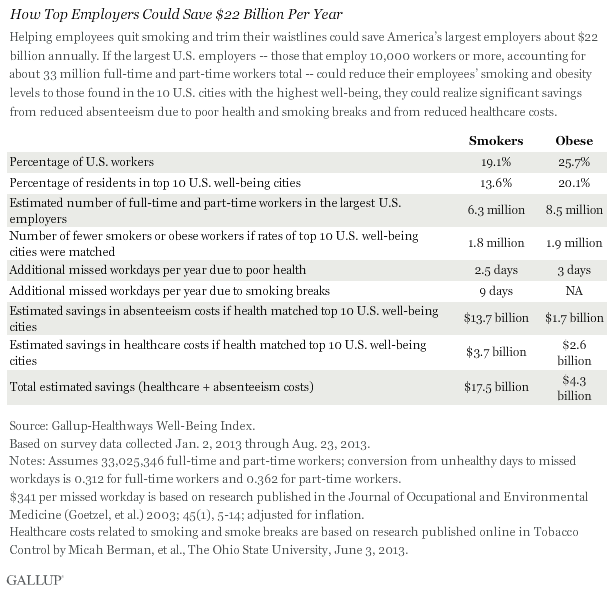Smokers and those who are obese report up to three additional missed workdays each year.
As the cost of healthcare continues to rise, U.S. companies are grappling with how to address it most effectively. These businesses could learn a great deal from U.S. cities with the highest well-being. The largest U.S. employers could reap about $22 billion in annual savings if their employees matched the smoking and obesity rates these top cities have achieved -- savings from reductions in absenteeism due to poor health and smoking breaks and from lower healthcare costs.
Gallup found that if the nation's largest employers -- those that employ 10,000 workers or more, accounting for about 33 million full-time and part-time workers total -- could reduce their employees' smoking and obesity levels to those found in the 10 U.S. cities with the highest well-being, they could realize significant savings.
- Smoking: 19.1% of all workers in the U.S. smoke. Lowering that percentage to 13.6% -- the rate in the top 10 U.S. cities for well-being -- would result in an estimated savings of $13.7 billion from reduced absenteeism and $3.7 billion from reduced healthcare costs each year -- or more than $17 billion annually.
- Obesity: 25.7% of all workers in the U.S. are obese. Lowering that percentage to 20.1% -- the rate in the top 10 U.S. cities for well-being -- would result in an estimated savings of $1.7 billion from reduced absenteeism and $2.6 billion from reduced healthcare costs each year -- or more than $4 billion annually.
The overall savings from reduced smoking and obesity rates would amount to an estimated $6.6 million in savings per year for every 10,000 workers these U.S.-based companies employ, or about $661 per year for each employee.

Smokers report about 2.5 additional missed workdays each year, while those who are obese report about three additional missed workdays each year, compared with their counterparts who don't smoke or who are not obese (after controlling for age, gender, race/ethnicity, household income, education, marital status, and region). The estimated cost of absenteeism to their respective employers is $341 per complete missed workday.
Partial-day absenteeism due to recurring smoke breaks also affects employers at an estimated cost of about $13 per workday or an accumulated cost of $3,077 per year. Healthcare costs for smokers are estimated at $2,056 per year in excess of the costs of non-smokers; for those who are obese, healthcare costs are estimated at $1,429 per year in excess of the costs for those who are not obese.
These findings are based on analysis of more than 67,000 interviews conducted from January 2-August 23, 2013, with American adults who work one hour or more per week. Interviews were conducted as part of the Gallup-Healthways Well-Being Index, a comprehensive measure of well-being that includes measures of obesity and smoking among its key metrics. Gallup calculated unhealthy days using respondents' answers to these questions: "During the past 30 days, for about how many days did poor health keep you from doing your usual activities?" and "How many actual workdays in the last month did you not work due to poor health?"
What business leaders can do
U.S. employers could reduce costs considerably -- and reap substantial productivity gains -- if their employees' smoking and obesity levels matched those already achieved by residents in the nation's cities with the highest well-being. Businesses could benefit significantly from developing public-private collaborations to apply best practices from these metro areas to increase well-being at work and in the community.
In addition, though smoking cessation and physical wellness programs are common in corporate workplaces, they often aren't optimally delivered. Cash incentives (typically offered through medical spending accounts), large-scale recognition systems, and competitions among teams or departments to improve their health outcomes can help catalyze action. Eliminating on-campus smoking and unhealthy food options and desserts in the cafeteria can make healthy choices more convenient. Posting nutritional information for every meal can make workers more aware of their caloric intake. And replacing candy bars and sugary beverages with protein bars and bottled water in the vending machines can lead to smarter choices.
Other approaches, however, are less obvious. Gallup and Healthways have analyzed key actions that organizations can take to improve well-being generally and to reduce smoking and obesity in particular. These include:
- Increase investment in learning. Workers have a built-in need to learn and grow. Cities that offer their residents rich opportunities to learn new and interesting things commonly have low obesity and low smoking rates. This is one reason why college towns or cities with a heavy academic presence rate so high for well-being. Companies that offer employees the opportunity to learn new and interesting things each day can increase their workers' willingness to embrace healthier lifestyles.
- Provide easy access to fresh fruits and vegetables. Eating fruits and vegetables is widely understood to be a healthy choice and is associated with both low obesity and low smoking rates -- and businesses can capitalize on this by making them easily available. Cities with high well-being often have farmers markets that are readily accessible to the public, grocery stores that prioritize high-quality produce, and restaurants that default to fruits or vegetables instead of fries with their entrees. Employers can apply these principles to the workplace by offering a fruit or vegetable choice with every cafeteria meal. Workers can also take turns bringing in fresh fruit or vegetables to share with their coworkers so there are always easy-to-grab fresh produce options.
- Make sure there are safe places to exercise. Nearly all cities with high well-being provide their residents with safe places to exercise, something workplaces can emulate. Though some employers provide on-site fitness centers, many are reluctant to do so despite the proven return on investment in enhanced productivity and reduced use of healthcare. Companies that are unwilling or unable to provide on-site exercise facilities could offer partial reimbursement for fitness center membership (with required proof of usage) or corporate partnerships that exchange large groups of memberships for discounted rates. To ensure that employees use these facilities, they must feel physically and psychologically secure entering and exiting. Businesses should subsidize membership only to fitness clubs that provide a safe environment for their employees, and employees must always feel welcome and encouraged to use facilities (internal or external) regardless of their health history or current health status.
- Get people to the dentist. People who go to the dentist at least once a year have considerably higher well-being than those who don't, which is one reason why a common feature of the U.S. cities with top well-being is good oral health. Those who maintain good oral health rate their lives more highly, are more likely to exercise and eat well each day, are less stressed in their daily lives, are less likely to be obese, and smoke less than people who don't get to the dentist regularly. Though most employers offer optional benefits that cover dental visits, few actively encourage their employees to choose this coverage or to visit a dentist on their own. By emphasizing oral health in the workplace and offering extra incentives to employees who visit a dentist, employers could gain significant return from the benefits of having a healthy set of teeth.
There is more to increasing well-being than just reducing smoking and obesity rates. The beneficial effects of working on multiple aspects of well-being at once have been well-documented. And there are additional factors that can affect a company's bottom line, from safety to turnover to presenteeism (when people show up at work but aren't productive), that can be measurably improved by increased employee well-being. Ultimately, executives need to choose between talking about supporting a well-being culture and actively making it happen in their business. Choosing the latter will be well worth the investment.
About the Gallup-Healthways Well-Being Index
The Gallup-Healthways Well-Being Index tracks well-being in the U.S. and provides best-in-class solutions for a healthier world. To learn more, please visit well-beingindex.com.
Survey Methods
Results are based on telephone interviews conducted as part of the Gallup-Healthways Well-Being Index survey with a random sample of 67,375 workers, aged 18 or over, from Jan. 2-Aug. 23, 2013. For results based on the total sample of national adults, one can say with 95% confidence that the maximum margin of sampling error is ±0.4 percentage points.
Interviews are conducted with respondents on landline telephones and cellular phones, with interviews conducted in Spanish for respondents who are primarily Spanish-speaking. Each sample includes a minimum quota of 50% cellphone respondents and 50% landline respondents, with additional minimum quotas among landline respondents by region. Landline and cellphone numbers are selected using random-digit-dial methods. Landline respondents are chosen at random within each household on the basis of which member had the most recent birthday.
Samples are weighted by gender, age, race, Hispanic ethnicity, education, region, adults in the household, and phone status (cellphone only/landline only/both, cellphone mostly, and having an unlisted landline number). Demographic weighting targets are based on the March 2012 Current Population Survey figures for the aged 18 and older non-institutionalized population living in U.S. telephone households. All reported margins of sampling error include the computed design effects for weighting and sample design.
In addition to sampling error, question wording and practical difficulties in conducting surveys can introduce error or bias into the findings of public opinion polls.
For more details on Gallup's polling methodology, visit https://www.gallup.com/.
